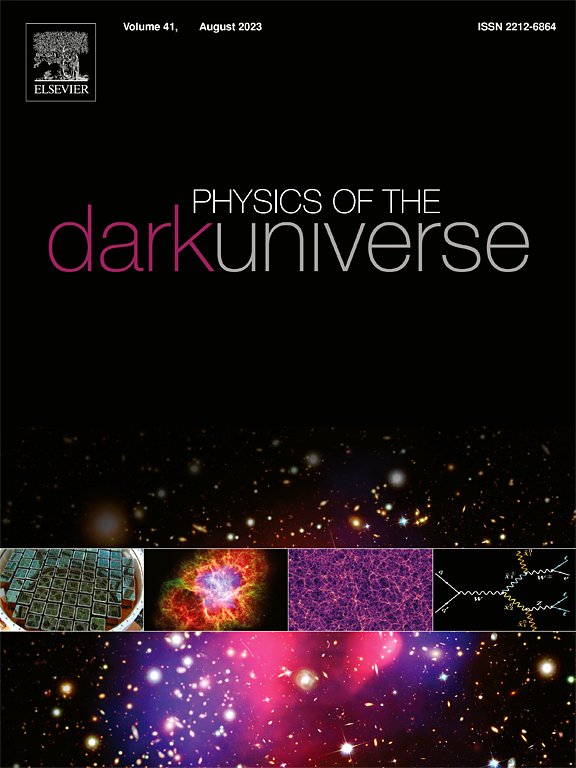热相变,蒸发,和黑洞的阴影在扩展重力与弦物质
IF 6.4
2区 物理与天体物理
Q1 ASTRONOMY & ASTROPHYSICS
引用次数: 0
摘要
黑洞的热力学和量子性质仍然是推进我们对引力、量子力学和高能物理理解的核心。由于经典电动力学在极端引力状态下的不足,并受到弦理论对扩展物质结构的预测的启发,这项工作探索了非线性电动力学(NLED)与黑洞物理中周围弦云之间丰富的相互作用。我们在爱因斯坦引力的框架内提出了一类新的规则AdS黑洞,由磁性NLED源和弦云修改,并对它们的热力学行为、蒸发动力学和观测特征进行了广泛的研究。一个关键的动机是发现外来场和高能修正是否可以改变经典预测并稳定黑洞以防止蒸发。结果表明:(1)偏差参数k、磁荷g和弦云参数a是黑洞热力学的调节因子,显著抑制了霍金辐射,延长了黑洞寿命;(ii)焦耳-汤姆逊膨胀表明,k和a的增加通过消除加热相和扩大冷却区域来增强热稳定性;(iii)与经典模型相比,量子引力对熵的修正诱导了更丰富和更复杂的相变,HPEM热力学几何形状一致地确定了临界点;(iv)标量摄动和灰体因子分析表明,在较高的k、a或g下,阻尼增强,辐射逸出减少,表明引力波特征的准正态模式和可观测偏差受到抑制;(v)在这三个参数的影响下,黑洞阴影半径会缩小,这为通过水平尺度成像进行观测约束开辟了新的可能性。本文章由计算机程序翻译,如有差异,请以英文原文为准。
Thermal phase transitions, evaporation, and shadows of regular black holes in extended gravity with stringy matter
The thermodynamics and quantum nature of black holes remain central to advancing our understanding of gravity, quantum mechanics, and high-energy physics. Motivated by the inadequacy of classical electrodynamics in extreme gravitational regimes and inspired by string theory’s prediction of extended matter structures, this work explores the rich interplay between nonlinear electrodynamics (NLED) and a surrounding cloud of strings on black hole physics. We present a novel class of regular AdS black holes within the framework of Einstein gravity, modified by both magnetic NLED sources and a cloud of strings, and perform an extensive investigation into their thermodynamic behavior, evaporation dynamics, and observational characteristics. A key motivation is to uncover whether exotic fields and high-energy corrections can alter classical predictions and stabilize black holes against evaporation. Our analysis reveals several striking results: (i) the deviation parameter , magnetic charge , and string cloud parameter act as regulators of black hole thermodynamics, significantly suppressing Hawking radiation and extending black hole lifetimes; (ii) Joule–Thomson expansion shows that increasing and enhances thermal stability by eliminating heating phases and broadening cooling regions; (iii) quantum gravity corrections to entropy induce richer and more complex phase transitions than those in classical models, with the HPEM thermodynamic geometry consistently identifying critical points; (iv) scalar perturbation and greybody factor analyses indicate stronger damping and reduced radiation escape under higher , , or , suggesting suppressed quasinormal modes and observable deviations in gravitational wave signatures; and (v) the black hole shadow radius shrinks under the influence of all three parameters, opening new possibilities for observational constraints via horizon-scale imaging.
求助全文
通过发布文献求助,成功后即可免费获取论文全文。
去求助
来源期刊

Physics of the Dark Universe
ASTRONOMY & ASTROPHYSICS-
CiteScore
9.60
自引率
7.30%
发文量
118
审稿时长
61 days
期刊介绍:
Physics of the Dark Universe is an innovative online-only journal that offers rapid publication of peer-reviewed, original research articles considered of high scientific impact.
The journal is focused on the understanding of Dark Matter, Dark Energy, Early Universe, gravitational waves and neutrinos, covering all theoretical, experimental and phenomenological aspects.
 求助内容:
求助内容: 应助结果提醒方式:
应助结果提醒方式:


